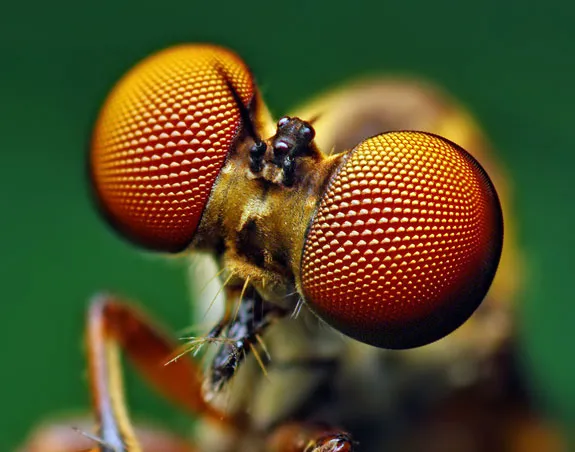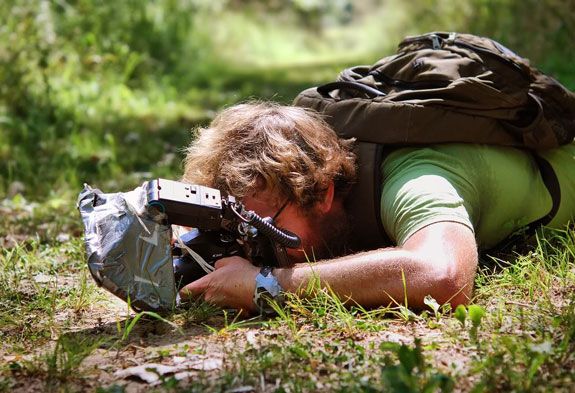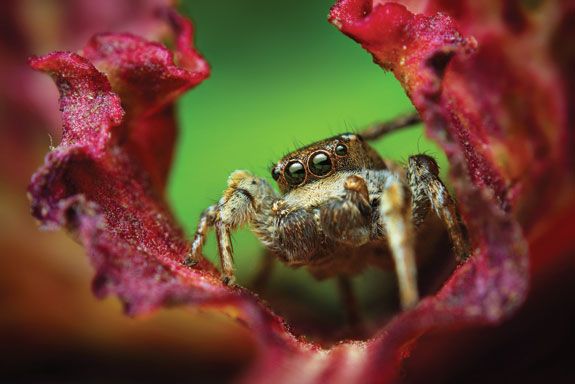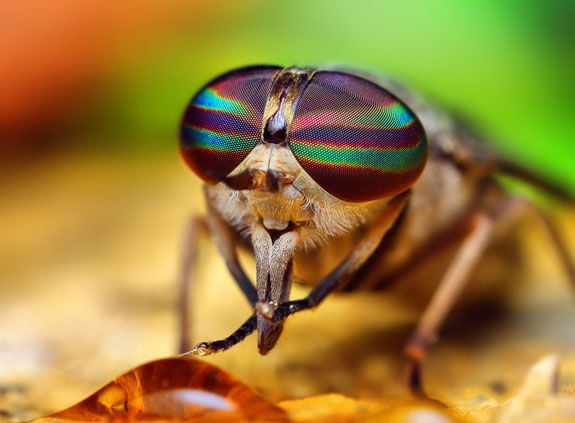Locking Eyes With Spiders and Insects
Macrophotographer Thomas Shahan takes portraits of spiders and insects in the hopes of turning your revulsion of the creatures into reverence
/https://tf-cmsv2-smithsonianmag-media.s3.amazonaws.com/filer/20130220121015Paraphidippus-aurantius-male-small.jpg)
Thomas Shahan came eye to eye with a jumping spider in his backyard about seven years ago when he was living and attending high school in Tulsa, Oklahoma. Since that first encounter, he has been “smitten,” according to a December 2011 spread of his macrophotography in National Geographic. “I began learning about their names and their ways, then looking for them in local parks and reserves like the Oxley Nature Center,” he wrote in the magazine.

For the past seven years, Shahan has developed a hobby of photographing arthropods—insects, such as robber flies and horse flies, and spiders—in his native Oklahoma. He captures their eyes and hairs in such colorful and glistening detail that his images, shared on Flickr, have been featured in Popular Photography, National Geographic and on NBC’s Today Show. (In fact, if you look up “jumping spider” on Wikipedia, you’ll even see, at the top of the page, a close-up of an adult male Phidippus audax jumping spider taken by Shahan.)

“I photograph arthropods because I love them and I want others to love them as well,” Shahan explained to me in an email. “I find them compelling. They are complex, fascinating and diverse animals that are all too often overlooked and unappreciated.”
Shahan prefers to shoot his subjects in their natural environs. “Now that I know where they are—their silhouettes are often visible through the leaves they perch upon—I can spot them quickly,” he wrote in National Geographic. Only occasionally does he bring his bugs indoors to stage them on a coffee table or other surface. Either way, “My subjects are always returned to where they are found and fed for their services if at all possible,” he told me.
Shahan’s ability to clearly capture individual spines on the legs of teensy-weensy spiders (jumping spiders measure anywhere from one to 22 millimeters in length) and the metallic sheen of their eyes might suggest that he uses fancy, top-of-the-line equipment. But, the photographer actually takes a do-it-yourself approach. “You can do a lot with a little,” says the 2011 graduate of University of Oklahoma, in printmaking, on his personal Web site. Currently, he uses a modestly priced Pentax DSLR camera with a set of modified extension tubes, a reversed 50-millimeter prime lens (a garage sale find!) and a diffused (and duct taped) homemade flash for lighting.

The macrophotographer is especially interested in the eyes of arthropods—and it’s the creatures’ eyes that attract the attention of viewers. To look into the face of creatures as small as a 4-millimeter jumping spider and “see yourself reflected in their large glossy eyes is incredibly humbling. To know they’ve evolved relatively little in millions of years is absolutely fascinating to me too; they’ve had those wonderful eyes for a long, long time,” said Shahan in an email. ”Additionally, from a photographic standpoint, the arthropod portraiture anthropomorphizes them considerably. To get down low and look up into their faces and eyes changes our usual perspective and has a propagandistic quality to it making them seem more important and powerful than us.”

In changing our visual perspective, Shahan ultimately wants to change our general feelings about bugs. ”I want to turn revulsion to reverence,” he said. “Arthropods are amazing animals and a good first step to appreciating and loving them is to simply take a closer look.”
“Beautiful Beasts: The Unseen Life of Oklahoma Spiders and Insects,” featuring 12 of Shahan’s photographs as well as the video, shown above, is on display at the Sam Noble Oklahoma Museum of Natural History through September 8, 2013.
/https://tf-cmsv2-smithsonianmag-media.s3.amazonaws.com/accounts/headshot/megan.png)
/https://tf-cmsv2-smithsonianmag-media.s3.amazonaws.com/accounts/headshot/megan.png)